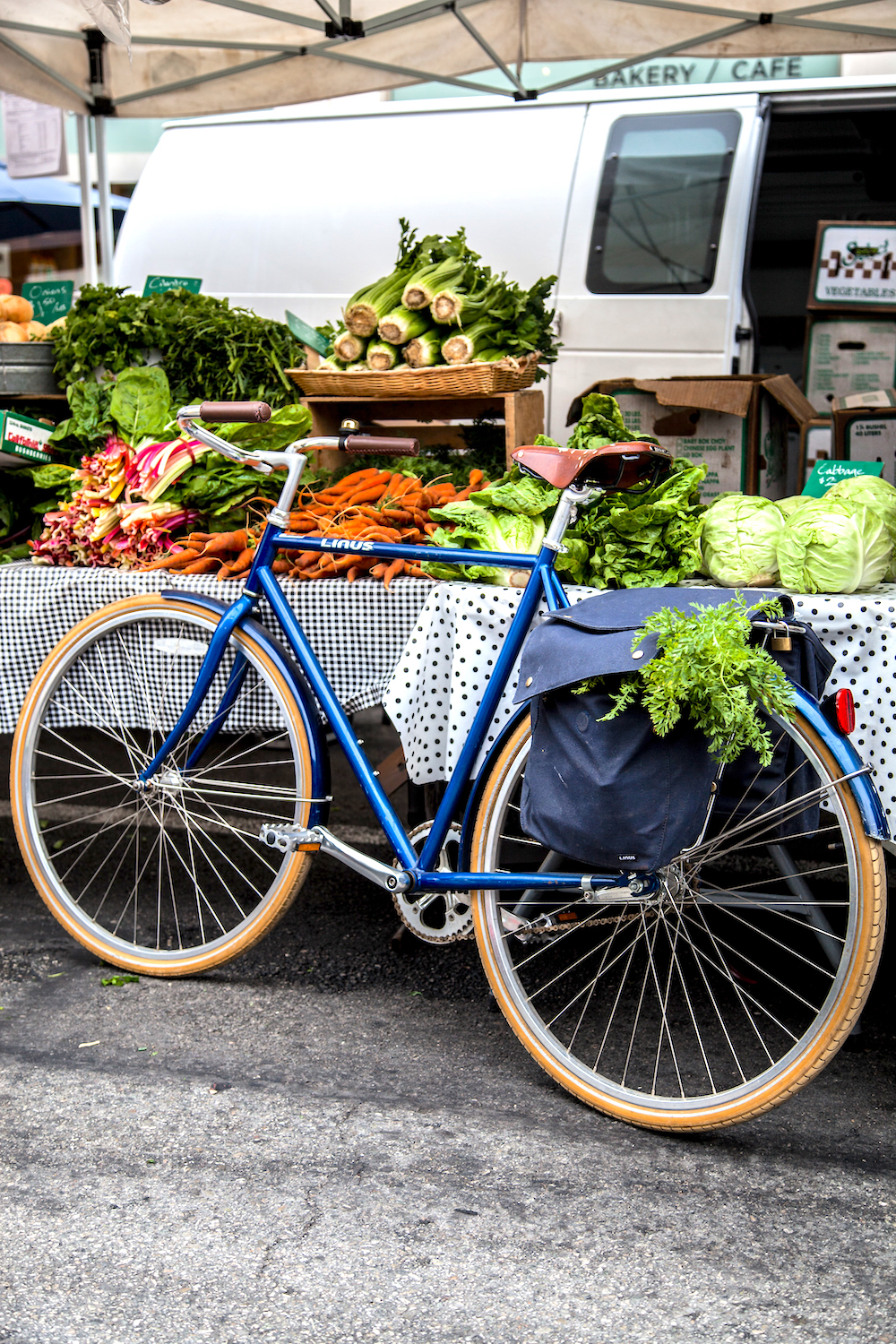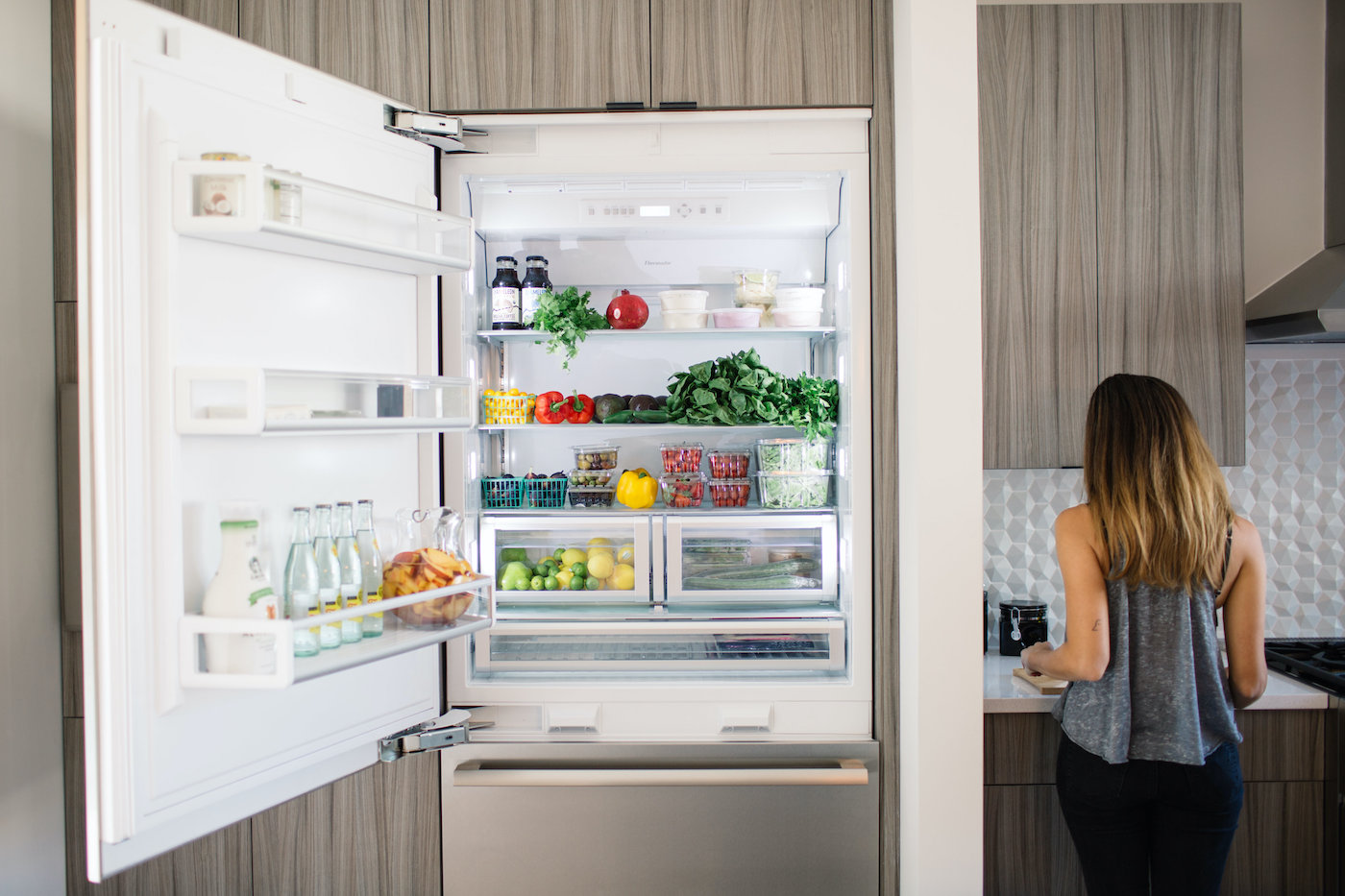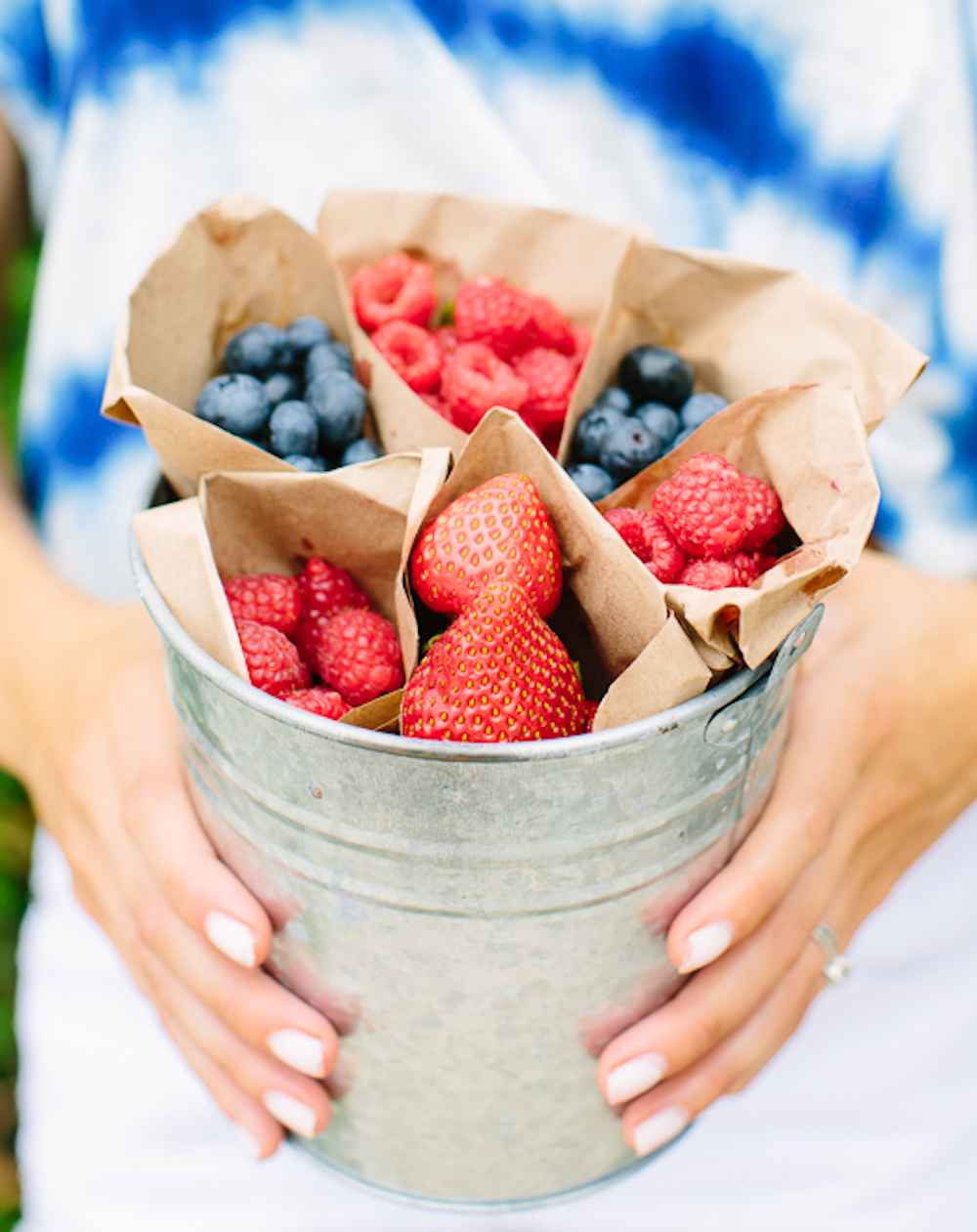ed. note: These tips are from Julia Watkin’s beautiful new book, Simply Living Well. For more information about the book, and Julia’s instructions on her furoshiki wrapping technique, click here. We thought that her tips on reducing food waste and how to make produce last longer felt especially fitting during this time when we’re all staying home. Now more than ever, it’s very important that we use (cook, store, share) what we have. It’s also a great time to learn pickling and freeze as much as possible. And don’t forget to eat your leftovers!

Do you ever load up on fresh fruits and veggies from the store only to find they’ve gone bad before you can even use them? I’ve fallen into this rut many times, and excitement around cooking evaporates as instant guilt for all of the wasted food (and funds) starts to set in.
I’ve often blamed this on poor planning on my part, but it turns out you can make your fruits and vegetables last a lot longer with some simple knowledge about your fridge and proper food storage techniques.
So, we asked Julia Watkins, author of Simply Living Well to share her tips on how to make produce last longer and extend the lifespan of our groceries. I found her advice to be both surprising at times and extremely helpful, and I quickly realized I had been doing it all wrong.
Scroll on for a few of her hacks on how to make produce last longer (and stay fresh) as well as a recipe for her waste-free broccoli stalk soup. Yep, you heard that right. She claims the stalks taste great, is packed with nutrients, and might be one of the most under-appreciated vegetables on the planet.
Materials
Instead of using plastic bags or wraps, Watkins recommends investing in special storage materials like silicone storage bags, beeswax wraps, and fitted cloth covers, or you can do what grandma did and use the containers and towels you already own.
Fridge Basics
The ideal temperature for keeping foods fresh is at or slightly below 40°F. If it gets much colder than that, tender foods like salad greens and herbs will freeze; if it gets warmer than 40°F, foods can spoil and become rancid. Since heat rises, the refrigerator is typically colder in the bottom drawers than on the top shelves. The warmer upper shelves are an ideal place for storing foods that aren’t likely to spoil. Think condiments, yogurt, leftovers, dips, and sauces. The bottom drawers, on the other hand, are the coldest place in the fridge, which makes them ideal for storing foods with the highest risk of going bad, such as meat, poultry, and fish.
Lastly, most refrigerators have what are called crisper drawers. A crisper is just a fancy word for a compartment designed for storing fruits and vegetables. Vegetables tend to do best in a high humidity crisper, while fruits keep longer in a low humidity crisper. Most refrigerators have two separate compartments marked accordingly. If your drawers aren’t marked, you can turn one drawer into a high humidity drawer by making sure it’s always closed tightly, and the other one into a low humidity drawer by leaving it slightly ajar.
Fruits
Apples. Wash only when ready to use. Store on a cool counter for up to two weeks. For longer storage, place in the fridge.
Avocados. Store on the counter or in a paper bag on the counter at room temperature. To stop from ripening, place in the fridge.
Bananas. Set on the counter at room temperature, away from other fruit. Once ripe, store in the fridge.
Berries. Wash only when ready to use. For blueberries, store in a covered bowl or container on a shelf in the refrigerator. For blackberries, raspberries, and strawberries, store in a single row on a tray, also on a shelf in the refrigerator; stack if necessary but place a damp cloth between layers. Eat within a couple of days.
Cherries. Wash only when ready to eat. Most of the time they’re sold ripe and should be refrigerated right away, in an airtight container.
Citrus. Store loose in the low-humidity crisper drawer.
Dates. Place in an airtight, sealed glass jar, in the fridge.
Figs. Wash only when ready to use. Store in an uncovered bowl on a shelf in the refrigerator.
Grapes. Wash only when ready to use. Keep unwashed bunches in a paper bag on the shelf of the refrigerator.
Melons. If unripe, store whole on a counter in a cool, dry place. Once ripe, store on a shelf in the refrigerator. If cut, refrigerate regardless of ripeness, in an airtight container.
Pears. Wash only when ready to use. If firm and unripe, store on the counter at room temperature. If soft and ripe, refrigerate in the low humidity drawer.
Tropical fruits (mangoes, papayas, pineapples). If unripe, store whole on the counter at room temperature. Once ripe, store loose on a shelf in the refrigerator or in a low humidity drawer.
Stone fruits (apricots, nectarines, peaches, plums). Wash only when ready to use. If unripe, store on the counter at room temperature. If ripe, refrigerate in a low humidity crisper drawer.

Vegetables
Asparagus. Trim ends and stand upright in a glass jar filled with one to two inches of water or wrap in a damp cloth and store in the high humidity drawer.
Beets. Wash only when ready to eat. Remove greens, leaving a one-inch stem on the root. Store beetroots and greens separately, in breathable produce bags in the high humidity drawer.
Broccoli. Wash only when ready to use. Store in the refrigerator in a breathable produce bag or wrap in a damp towel in the high humidity drawer.
Carrots. Wash only when ready to use. Trim greens, leaving one inch attached. Store carrots in a breathable bag in the crisper drawer or upright in a sealed glass container filled with water. Store greens in a breathable bag in the high humidity drawer. Greens can be used like herbs in various dishes.
Celery. Place standing in a jar filled with water, on a shelf in the refrigerator, or in a mesh produce bag in the high humidity drawer.
Corn on the cob. Eat immediately, if possible – it doesn’t stay fresh for long.
Cucumber. Store on the counter at room temperature or wrapped in a damp cloth and placed in a breathable bag and stored in the high humidity drawer.
Garlic/Onions. If unpeeled, store on the counter, in a cool, dark place. If peeled, store in an airtight container in the refrigerator.
Ginger. Store unwrapped or in an airtight container in the refrigerator.
Green beans and peas. Store in a breathable bag in the high humidity drawer.
Hearty greens (beet greens, cabbage chard, collard greens, kale). Wash only when ready to use. Remove rubber bands, wrap in a damp towel, and store in the high humidity drawer.
Mushrooms. Wash only when ready to use. Store in a paper bag in the high humidity drawer or on a lower shelf in the refrigerator.
Onions. Store in a cool, dark, well-ventilated area. Hanging sacks or baskets work well as they encourage ventilation. Keep away from potatoes – onions will encourage them to sprout!
Peppers. Store in a breathable bag in the low humidity drawer. Once cut, store in an airtight container in the refrigerator.
Potatoes and winter squash. Store in an open basket in a cold, dry, well-ventilated area. Store separately from onions.
Salad greens (lettuce, arugula, endive, radicchio, spinach). Wash only when ready to use. Store upright in a glass of water on the counter or wrap in a damp cloth and store in the high humidity drawer.
Summer squash. Wash only when ready to use. Store in a breathable bag in the crisper in the refrigerator. Once cut, wrap in a damp towel and continue to store in a high humidity drawer.
Tomatoes. If uncut, store on the counter at room temperature, away from sunlight. Once cut, store in the refrigerator for up to 2-3 days.
Herbs (except basil). Prepare like a flower bouquet: trim stems and place in water, store in the refrigerator. For basil, store in an airtight container, loosely packed with a damp cloth.
Do you have tips on how to make produce last longer? Share them below and let us know if this post was helpful!
Waste-Free Broccoli Stalk Soup
Serves 8
Simple Hacks to Make Fruits & Veggies Last Their Longest
Categories
From Simply Living Well by Julia Watkins
Ingredients
- 2 tablespoons unrefined coconut oil
- 1 medium onion, chopped
- 1 celery rib, chopped
- 1 leek, trimmed and sliced
- 3 garlic cloves, chopped
- 1 tsp chopped fresh flat parsley
- 1 ½ pounds broccoli florets and stalks, ends removed,
- tough woody layers peeled, and chopped (about 8 cups) chopped
- 2 medium Yukon potatoes, chopped
- 8 cups vegetable stock
- 4 cups fresh spinach, stems removed
- 1 14-ounce can full-fat coconut milk
- 1-2 tablespoons fresh lemon juice, to taste
- kosher sea salt and fresh ground pepper, to taste
Instructions
- Remove ends and tough woody layers from the broccoli stalks.
- In a large pot, melt the coconut oil over medium heat.
- Add the onion and leek and sauté until tender and translucent, 10 to 15 minutes.
- Add the garlic and parsley and cook until fragrant, about 30 seconds.
- Add the broccoli, potato, and stock. Bring to a boil over high heat, then reduce to a simmer. Cook until the vegetables are tender, about 20 minutes.
- Add the spinach and cook for 1 minutes.
- Remove the pot from the heat and puree the soup using an immersion blender. (Alternatively, you can transfer the soup, in bathes if necessary, to a countertop blender. When blending hot liquids, be sure to remove the center cap from the lid and hold a clean dish towel over the hotel to allow steam to escape).
- Transfer the pureed soup back to the pot.
- Stir in the coconut milk or heavy cream and heat for one minute.
- Remove from the heat and add the lemon juice, salt, and pepper. Serve warm.
- To store leftovers, allow the soup to cool, then transfer to airtight containers. Freeze for up to 6 months.







